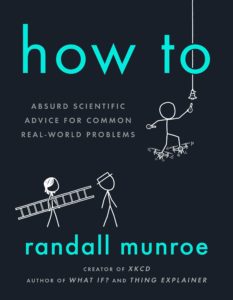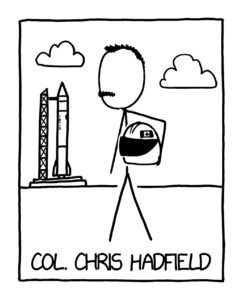Randall Munroe, creator of xkcd, asks how to do various things — jump really high, throw things, build a lava moat, and a couple dozen more — and considers approaches that are both sound and absurd. Hilarity ensues. The book begins with an earnest disclaimer, a plea not to take the title as a guide. “Do not try any of this at home. The author of this book is an internet cartoonist, not a health or safety expert. He likes it when things catch fire or explode, which means he does not have your best interests in mind.”
If that did not drive the point home, the first sentence of the introduction reads, “This is a book of bad ideas.” He then undercuts himself by saying that although “smearing mold on an infected wound sounds like a terrible idea,” that is basically what penicillin is. The underlying matter of the book, then, is not just how to tell good ideas from bad, but how exploring even cockamamie ideas can lead to interesting insights and, occasionally, solutions to apparently intractable problems. You might not think that lowering a heavy rover on a tether from a hovering spacecraft is the best way to get the rover to the surface of Mars. In fact, at first glance it would appear either impossible or overly complicated, but that is in fact how Curiosity touched down, for reasons that Munroe explains.
He adds, “This book explores unusual approaches to common tasks, and looks at what would happen to you if you tried them. Figuring out why they would or wouldn’t work can be fun and informative and sometimes leads you to surprising places. Maybe an idea is bad, but figuring out exactly why it’s a bad idea can teach you a lot—and might help you think of a better approach.”
Sometimes there’s no better approach at the end of the chapter, but getting there is fun and interesting enough that that doesn’t matter. Consider chapter 16, “How to Power Your House (on Earth).” Munroe looks at growing plants to burn to generate electricity to power the needs of a typical American household and comes up woefully short. If, however, the United States were a uniform plateau at its average elevation and “with rain falling across it and spilling over its edges” it hydropower would generate about 14 times the amount that each household uses. “Unfortunately for your house, that’s a very optimistic assessment.” (p. 172) He then considers various forms of power from the earth, such as geothermal energy of harnessing the forces of plate tectonics. Would the latter work? “In theory, yes! … The whole system is ridiculous and technically infeasible for a lot of reasons — and if you tried to build one, you’d probably discover some new ones.” (pp. 174–75) But such a system would pay for itself in a mere 36 million years. Both solar and wind power have more reasonable returns on the necessary investment. Finally, Munroe considers something from quantum theory. In some models of the universe, the aftermath of the Big Bang is still unsettled, with the quantum fields that make up all particles existing in a “false vacuum.” Munroe continues. “[S]pace-time itself contains a certain amount of tension, and if perturbed in the right way, this tension could be released, and space would fall into a fully relaxed, settled state.”
Would this be a good idea?
To answer this question, I contacted astrophysicist and end-of-the-universe specialist Dr. Katie Mack. I asked Dr. Mack how much power would be released if someone triggered vacuum decay in their yard, and whether it could be harnessed to power their home. Her response: ‘Please do not do that.’
‘If you could decay the vacuum locally, it would in principle release the energy of the Higgs field, probably in the form of extremely high energy radiation,’ she said, ‘but along with that energy you’d get a bubble of true vacuum expanding at the speed of light, making it impossible to harness any of the energy before the bubble envelops you. That true vacuum bubble would incinerate you, then destroy all your particles, and then devour the entire Universe. And then immediately collapse it.’ (p. 179)
In the chapter that immediately follows, Munroe considers how to power your house, if your house happens to be on Mars.
Sometimes other guests get in on the act. Serena Williams, for example, provides empirical data on taking down a typical drone with a tennis ball. Among athletes, though, Olympic archers still rank first for that task. “Pitchers would also be a great choice—and a baseball would probably do a lot of damage. Basketball players make up for their lower accuracy with a large projectile and efficient arcing shot.” (p. 227)
My favorite guest was Col. Chris Hadfield, test pilot, astronaut, commander of the International Space Station. “I made a list of unusual and improbably emergency landing scenarios, then called him up and posed each one to him to see how he would respond. I half expected him to hang up on me after the second or third question, but to my surprise, he answered every one with virtually no hesitation. (In retrospect, my plan to fluster an astronaut by throwing extreme situations at him might have been flawed.)” Indeed. Test pilot and astronaut training is thorough. Hadfield knew which times of year were good to land in which crops if a small family should suddenly come a cropper. Hadfield is even droller than Munroe.
Here he is regarding landing on a submarine, having already disposed with landing on aircraft carriers (friendly and hostile) and trains, “Yes, if it’s on the surface, driving fast into wind, and you have a slow, stable airplane. Like landing on a skinny, short, wet runway. I think it’s been done. Sometimes hard to find a submarine when you need one, though.” (p. 51) After several variations on landing the Space Shuttle, Munroe asks what to do if he is in the shuttle while it’s attached to the carrier aircraft and the pilot of that vehicle has bailed out. What to do? Here’s Hadfield, unflummoxed: “The initial flights of the Space Shuttle were drop tests from the Shuttle Carrier Aircraft. So I’d wait until you’re within gliding range of a suitable runway, fire the separating mechanism from the SCA, pull back firmly to miss the SCA’s tail, and then glide to a landing. Easy peasy.” (p. 56)
The whole book is like that. It’s a hoot, bad ideas and all.


